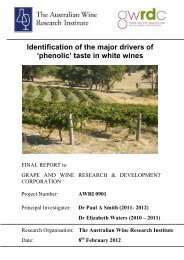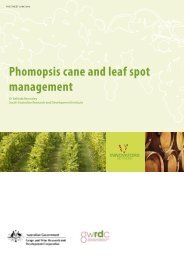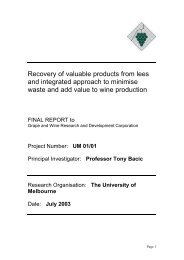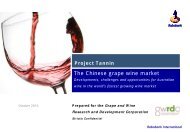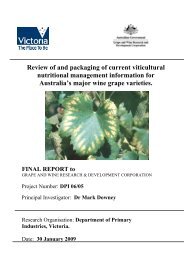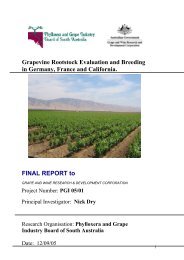Matter other than grapes (MOG) - GWRDC
Matter other than grapes (MOG) - GWRDC
Matter other than grapes (MOG) - GWRDC
You also want an ePaper? Increase the reach of your titles
YUMPU automatically turns print PDFs into web optimized ePapers that Google loves.
Current topics in this Winegrape<br />
Assessment Series include:<br />
Grower and winery<br />
expectations in grape<br />
production<br />
Grape maturity<br />
1. Total soluble solids, pH and<br />
titratable acidity<br />
2. Colour in red grape varieties<br />
3. Cropping levels<br />
Grape purity<br />
1. Diseases - powdery mildew,<br />
downy mildew, Botrytis and <strong>other</strong><br />
moulds and rots.<br />
2. Agrochemical residues<br />
3. <strong>Matter</strong> <strong>other</strong> <strong>than</strong> <strong>grapes</strong> (<strong>MOG</strong>)<br />
4. Contamination<br />
Grape condition<br />
1. Uneven ripening<br />
2. Temperature<br />
3. Spoilage<br />
4. Damaged berries<br />
*Vitinotes in this series have<br />
been sources from Winegrape<br />
assessment in the vineyard and at<br />
the winery, the 2003 WGCA-WFA<br />
Liaison Committee report to the<br />
Grape and Wine Research and<br />
Development Corporation.<br />
Viti-Notes<br />
www.crcv.com.au 2005<br />
What wineries want…..and why: Winegrape assessment in the vineyard and at the winery<br />
G rape purity 3. <strong>Matter</strong> <strong>other</strong> <strong>than</strong> <strong>grapes</strong> (MO G )<br />
Fungal diseases, agrochemical residue,<br />
contaminants, any matter <strong>other</strong> <strong>than</strong> <strong>grapes</strong> (<strong>MOG</strong>)<br />
and a mixture of varieties are detrimental in a load<br />
of wine<strong>grapes</strong>, and while 100% purity can be<br />
difficult to achieve it must be the aim of every<br />
grower. Grapes are classified as food and therefore<br />
have to comply with Food Standards for Australia<br />
and New Zealand.<br />
<strong>MOG</strong> includes all <strong>other</strong> vine material such as<br />
petioles, leaves, canes and broken arms of vines. It<br />
also includes foreign objects such as stones, picking<br />
utensils, trellis parts, metal objects and irrigation<br />
components. These are often difficult to detect in<br />
loads until in the crusher, which can be damaged by<br />
such inclusions, but it is highly variable as to how<br />
much material or how big an object will cause<br />
damage.<br />
With expanded use of machine harvesting since the<br />
late 1970s, <strong>MOG</strong> has become an issue as most<br />
contaminants (<strong>other</strong> <strong>than</strong> chemicals) are directly<br />
related to mechanisation, although, to a lesser<br />
extent, <strong>MOG</strong> can also be present in hand-picked<br />
loads. Machine harvesting technology has been<br />
changing in recent years to greatly improve<br />
harvesting techniques and to reduce the amount of<br />
<strong>MOG</strong>. Improvement is still needed, however, and<br />
often the skill of the harvester operator can play a<br />
major role in the purity of the load.<br />
Growers can also reduce the occurrence of <strong>MOG</strong> in<br />
harvest loads by:<br />
• Ensuring vine rows are clear of foreign objects.<br />
• Controlling snails and <strong>other</strong> potential pests.<br />
• Cleaning up vines after machine pruning to<br />
remove potential <strong>MOG</strong>, eg. the brittle dead arms<br />
caused by Eutypa.<br />
What are the implications of not meeting specifications?<br />
• Losses can occur through processing problems<br />
caused by <strong>MOG</strong>, downtime for repairs to equipment,<br />
and the cost of equipment replacement. In some<br />
situations wineries have written into their grape<br />
purchasing agreements that growers may be liable<br />
for the cost of repairs if fault is established.<br />
• <strong>MOG</strong> can be detrimental to grape quality<br />
because of skin and berry damage, especially for<br />
white varieties.<br />
• Wine quality can be affected through too much<br />
leaf in loads causing unwanted herbaceous<br />
character. Excessive leaves in the load may also<br />
increase the risk of agrochemical residue from<br />
vineyard sprays.<br />
• Excessive <strong>MOG</strong> means wineries are paying for<br />
unwanted quantities waste which must be removed<br />
at the crushing site.<br />
What are some causes of not meeting specifications?<br />
Common causes of problems are:<br />
• Poorly set up machine harvester units.<br />
• Absence of,or poorly maintained magnets on harvesters.<br />
• Harvesting of vines late in the season when they<br />
may be stressed and <strong>grapes</strong> are difficult to remove.<br />
• Frost damage to vines resulting in dead shoots<br />
that easily break off.<br />
• Stressed vines in general, where leaves fall easily<br />
and vine wood is often more brittle <strong>than</strong> normal.<br />
• Harvesting in wet conditions where water weighs<br />
down leaves and sticks and the harvester fans are<br />
unable to remove them.<br />
• Poor pruning techniques in the vineya r d ,<br />
especially where hand clean-up following machine<br />
pruning has been inadequate.<br />
• Minimally pruned vines can increase the potential for<br />
M O G, as there is a considerable amount of dry and dead<br />
wood present where no pruning has occurred.
• Old vines that contain considerable amounts of dead wood<br />
(possibly due to Eutypa or <strong>other</strong> trunk diseases).<br />
• Poorly re-trellised vines that have not had the old wood removed.<br />
• Objects left in the vineyard to mark posts and sprinkler heads not<br />
removed prior to harvest.<br />
• Failure to inspect bins and remove foreign objects prior to use.<br />
How specifications are evaluated<br />
TAKING SAMPLES<br />
The <strong>MOG</strong> content of a load can be quantified by extracting and<br />
weighing samples but this is inefficient, time-consuming and too<br />
complicated to be a practical measurement tool, as sampling would<br />
need to be representative of the entire load.<br />
RATING<br />
<strong>MOG</strong>-0<br />
<strong>MOG</strong>-1<br />
<strong>MOG</strong>-2<br />
<strong>MOG</strong>-3<br />
<strong>MOG</strong>-4<br />
<strong>MOG</strong>-5<br />
www.crcv.com.au<br />
PERCENTAGE<br />
<strong>MOG</strong><br />
Delivering <strong>grapes</strong> to specification<br />
• It is Best Practice by the grower to deliver <strong>grapes</strong> at <strong>MOG</strong>-0 rating.<br />
• Many grape purchasing agreements apply a minimum or<br />
maximum tolerance - a measure for a specification above or below<br />
which penalties generally apply, or <strong>grapes</strong> may be unacceptable<br />
to the winery. Many wineries have a maximum tolerance for <strong>MOG</strong> -<br />
generally this is <strong>MOG</strong>-2 rating. Deliver <strong>grapes</strong> within the tolerance<br />
where a winery has written the specification to avoid penalties,<br />
especially where it may affect pricing or rejection is a risk.<br />
• The winery must notify growers of results which do not meet<br />
specifications (within 2 hours is acceptable), to discuss the outcome.<br />
The appropriate winery staff should also be contacted immediately as<br />
load processing may be delayed.<br />
THE CRC for Viticulture is a joint ve n t u re between the fo l l owing core participants,<br />
working with a wide range of supporting partners.<br />
Further information<br />
1 This guide is out of print in its original format, but similar information<br />
can be found in the publication Growing <strong>grapes</strong> to winery<br />
specifications, available from Winetitles<br />
Product or service information is provided to inform the viticulture<br />
industry about available resources, and should not be interpreted as an<br />
endorsement.<br />
A useful reference is:<br />
• Growing quality <strong>grapes</strong> to winery specifications, 2003,<br />
edited by Sally Collings and available from Winetitles<br />
• Research to Practice is a training program whose delivery can<br />
be fine-tuned to suit each region. Enquiries to Peter Mansfieldon (08)<br />
8222 9255 or visit www. c r c v.com.au/education/rtp/ for more<br />
information.<br />
Visit the web site at www.crcv.com.au/viticare/vitinotes/ for updates<br />
and more Vitinote titles.<br />
©2005 Cooperative Research Centre for Viticulture



